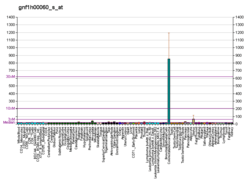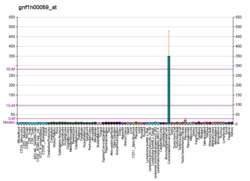AXIN2
Axin-2 also known as axin-like protein (Axil) or axis inhibition protein 2 (AXIN2) or conductin is a protein that in humans is encoded by the AXIN2 gene.[5][6]
Function
The Axin-related protein, Axin2, presumably plays an important role in the regulation of the stability of beta-catenin in the Wnt signaling pathway, like its rodent homologs, mouse conductin/rat axil. In mouse, conductin organizes a multiprotein complex of APC (adenomatous polyposis of the colon), beta-catenin, glycogen synthase kinase 3-beta, and conductin, which leads to the degradation of beta-catenin.[6]
Clinical significance
The deregulation of beta-catenin is an important event in the genesis of a number of malignancies. The AXIN2 gene has been mapped to 17q23-q24, a region that shows frequent loss of heterozygosity in breast cancer, neuroblastoma, and other tumors. Mutations in this gene have been associated with colorectal cancer with defective mismatch repair.[6]
The most critical events of teeth, lip and palate formation occur almost concurrently. Hypodontia, defined as the congenital lack of one or more permanent teeth, is the most common dental abnormality found in humans and affects approximately 20% of the population worldwide.[7] AXIS inhibition protein 2 (AXIN2) gene polymorphic variants may be associated with both hypodontia and oligodontia (characterized by the lack of six or more permanent teeth).[8][9] Mutations of this gene have been found in individuals with colorectal carcinomas and liver tumors.[10]
An AXIN2 mutation (1966C>T) detected in a Finnish family was associated with both tooth agenesis and colon neoplasia. In essence, the mutation seems to disrupt tooth development early in life and later contributes to the emergence of polyps and eventually colon cancer, an observation that suggests that the lack of permanent teeth may be an indicator of colon cancer susceptibility.[8] Dentists may at the very least need to remain aware of the possible association, to be able to detect such cases of tooth agenesis and forward the patient to more complete genetic diagnostic examinations. This is a simple example of how molecular genetic discoveries today interact with traditional disciplines (Longtin, 2004).
Interactions
AXIN2 has been shown to interact with GSK3B.[11][12]
References
- GRCh38: Ensembl release 89: ENSG00000168646 - Ensembl, May 2017
- GRCm38: Ensembl release 89: ENSMUSG00000000142 - Ensembl, May 2017
- "Human PubMed Reference:". National Center for Biotechnology Information, U.S. National Library of Medicine.
- "Mouse PubMed Reference:". National Center for Biotechnology Information, U.S. National Library of Medicine.
- Mai M, Qian C, Yokomizo A, Smith DI, Liu W (May 1999). "Cloning of the human homolog of conductin (AXIN2), a gene mapping to chromosome 17q23-q24". Genomics. 55 (3): 341–4. doi:10.1006/geno.1998.5650. PMID 10049590.
- "Entrez Gene: AXIN2 axin 2 (conductin, axil)".
- Vastardis H (June 2000). "The genetics of human tooth agenesis: new discoveries for understanding dental anomalies". Am J Orthod Dentofacial Orthop. 117 (6): 650–6. doi:10.1016/s0889-5406(00)70173-9. PMID 10842107.
- Lammi L, Arte S, Somer M, Jarvinen H, Lahermo P, Thesleff I, Pirinen S, Nieminen P (May 2004). "Mutations in AXIN2 Cause Familial Tooth Agenesis and Predispose to Colorectal Cancer". Am. J. Hum. Genet. 74 (5): 1043–50. doi:10.1086/386293. PMC 1181967. PMID 15042511.
- Mostowska A, Biedziak B, Jagodzinski PP (2006). "Axis inhibition protein 2 (AXIN2) polymorphisms may be a risk factor for selective tooth agenesis". J. Hum. Genet. 51 (3): 262–6. doi:10.1007/s10038-005-0353-6. PMID 16432638.
- Salahshor S, Woodgett JR (March 2005). "The links between axin and carcinogenesis". J. Clin. Pathol. 58 (3): 225–36. doi:10.1136/jcp.2003.009506. PMC 1770611. PMID 15735151.
- von Kries JP, Winbeck G, Asbrand C, Schwarz-Romond T, Sochnikova N, Dell'Oro A, Behrens J, Birchmeier W (September 2000). "Hot spots in beta-catenin for interactions with LEF-1, conductin and APC". Nat. Struct. Biol. 7 (9): 800–7. doi:10.1038/79039. PMID 10966653.
- Schwarz-Romond T, Asbrand C, Bakkers J, Kühl M, Schaeffer HJ, Huelsken J, Behrens J, Hammerschmidt M, Birchmeier W (August 2002). "The ankyrin repeat protein Diversin recruits Casein kinase Iε to the β-catenin degradation complex and acts in both canonical Wnt and Wnt/JNK signaling". Genes Dev. 16 (16): 2073–84. doi:10.1101/gad.230402. PMC 186448. PMID 12183362.
Further reading
- Kikuchi A (2000). "Modulation of Wnt signaling by Axin and Axil". Cytokine Growth Factor Rev. 10 (3–4): 255–65. doi:10.1016/S1359-6101(99)00017-9. PMID 10647780.
- Segditsas S, Tomlinson I (2007). "Colorectal cancer and genetic alterations in the Wnt pathway". Oncogene. 25 (57): 7531–7. doi:10.1038/sj.onc.1210059. PMID 17143297.
- Bonaldo MF, Lennon G, Soares MB (1997). "Normalization and subtraction: two approaches to facilitate gene discovery". Genome Res. 6 (9): 791–806. doi:10.1101/gr.6.9.791. PMID 8889548.
- Liu W, Dong X, Mai M, Seelan RS, Taniguchi K, Krishnadath KK, Halling KC, Cunningham JM, Boardman LA, Qian C, Christensen E, Schmidt SS, Roche PC, Smith DI, Thibodeau SN (2000). "Mutations in AXIN2 cause colorectal cancer with defective mismatch repair by activating beta-catenin/TCF signalling". Nat. Genet. 26 (2): 146–7. doi:10.1038/79859. PMID 11017067.
- Dong X, Seelan RS, Qian C, Mai M, Liu W (2001). "Genomic structure, chromosome mapping and expression analysis of the human AXIN2 gene". Cytogenet. Cell Genet. 93 (1–2): 26–8. doi:10.1159/000056942. PMID 11474173.
- Leung JY, Kolligs FT, Wu R, Zhai Y, Kuick R, Hanash S, Cho KR, Fearon ER (2002). "Activation of AXIN2 expression by beta-catenin-T cell factor. A feedback repressor pathway regulating Wnt signaling". J. Biol. Chem. 277 (24): 21657–65. doi:10.1074/jbc.M200139200. PMID 11940574.
- Anderson CB, Neufeld KL, White RL (2002). "Subcellular distribution of Wnt pathway proteins in normal and neoplastic colon". Proc. Natl. Acad. Sci. U.S.A. 99 (13): 8683–8. doi:10.1073/pnas.122235399. PMC 124359. PMID 12072559.
- Kouzmenko AP, Takeyama K, Ito S, Furutani T, Sawatsubashi S, Maki A, Suzuki E, Kawasaki Y, Akiyama T, Tabata T, Kato S (2004). "Wnt/beta-catenin and estrogen signaling converge in vivo". J. Biol. Chem. 279 (39): 40255–8. doi:10.1074/jbc.C400331200. PMID 15304487.
- Hughes TA, Brady HJ (2005). "Expression of axin2 is regulated by the alternative 5'-untranslated regions of its mRNA". J. Biol. Chem. 280 (9): 8581–8. doi:10.1074/jbc.M410806200. PMID 15611123.
- Hughes TA, Brady HJ (2005). "E2F1 up-regulates the expression of the tumour suppressor axin2 both by activation of transcription and by mRNA stabilisation". Biochem. Biophys. Res. Commun. 329 (4): 1267–74. doi:10.1016/j.bbrc.2005.02.102. PMID 15766563.
- Koinuma K, Yamashita Y, Liu W, Hatanaka H, Kurashina K, Wada T, Takada S, Kaneda R, Choi YL, Fujiwara SI, Miyakura Y, Nagai H, Mano H (2006). "Epigenetic silencing of AXIN2 in colorectal carcinoma with microsatellite instability". Oncogene. 25 (1): 139–46. doi:10.1038/sj.onc.1209009. PMID 16247484.
- Liu W, Rui H, Wang J, Lin S, He Y, Chen M, Li Q, Ye Z, Zhang S, Chan SC, Chen YG, Han J, Lin SC (2006). "Axin is a scaffold protein in TGF-β signaling that promotes degradation of Smad7 by Arkadia". EMBO J. 25 (8): 1646–58. doi:10.1038/sj.emboj.7601057. PMC 1440825. PMID 16601693.
- Lejeune S, Guillemot F, Triboulet JP, Cattan S, Mouton C, Porchet N, Manouvrier S, Buisine MP (2006). "Low frequency of AXIN2 mutations and high frequency of MUTYH mutations in patients with multiple polyposis". Hum. Mutat. 27 (10): 1064. doi:10.1002/humu.9460. PMID 16941501.
External links
- AXIN2 human gene location in the UCSC Genome Browser.
- AXIN2 human gene details in the UCSC Genome Browser.





